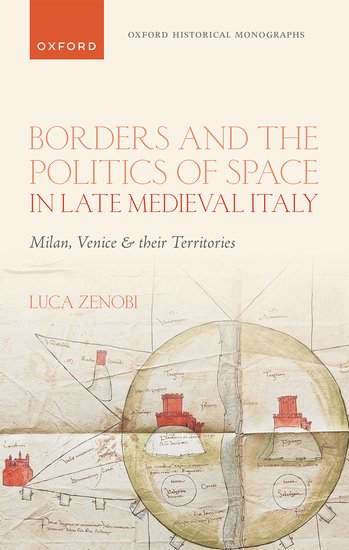


Reviewer Francesco Salvestrini - Università di Firenze
CitationThe control and political administration of the territories of two of the most important centers in late-medieval northern Italy is the subject of a book by an Italian author recently published by Oxford University Press. The main theme of this monograph is the drawing of boundaries between the regions dominated by Milan and Venice’s Terraferma. In seven chapters and a conclusion, the author discusses the decisions of central powers and local communities to define the spatial boundaries of larger urban centers, while highlighting the similarities and differences between the two major cities. In fact, Milan was a duchy long committed to the nobility (signoria), while Venice was an oligarchic republic. Their different political systems are reflected in various cultural traditions that are described by historians of the period, such as Machiavelli and Guicciardini.
The author examines several aspects of the theme of borders. He begins by outlining the concept of territoriality, as presented by legal scholars and power theorists and practised by local governors and officials, who left letters, reports, surveys and accounts. Thus, he examines the concept of borders expressed by intellectuals and government officials. The author then turns to military conflicts that sought to redefine spheres of influence. He examines the texts of the most significant peace agreements – the treaties of Ferrara of 1428 and 1433, the treaty of Cremona of 1441 and the Peace of Lodi of 1454 – to highlight the shifts in the geography of power that established clearly defined, well-negotiated spatial boundaries, resulting from the confirmation of previous borders and a new balance of power at supralocal level. For the signatories of these treaties, the documented precision of these boundaries was a prerequisite for mutual compliance with the agreements reached. Next, the book looks at border disputes, providing an insightful analysis of how borders are perceived by the center (the city-states) and the periphery (the medium-sized centers within their territories). As is inevitable in a work of this nature, border crossings, typically for commercial and military purposes, and the types of goods transported, are discussed in detail. The author continues with a somewhat predictable, though appropriate examination of how borders are represented in writing and in cartography, and shows how borders gradually acquired relative linearity and thus continuity.
The definition of territorial boundaries is an established theme in historiography that is discussed both historiographically and anthropologically. One of the merits of Zenobi’s book is that it expands on research that has focused primarily on Europe’s emerging nation-states to include Italy. His reinterpretation of these themes is also interesting. The aim is to show that the liminal boundaries of medieval and early Renaissance political organizations were not as ambiguous and porous as critics have long believed, especially after they were redefined in the late fourteenth century. The author challenges another long-established concept: that territorial powers exercised unpredictable, agreement-dependent and largely fragmented control over these spaces. Zenobi again emphasizes the demarcation of areas that were conceptually clear to the people of the time and were therefore highlighted both in physical space and on maps. The author contends that these areas were controlled and defended because they coincided with the iurisdictio of each territorial regime. This was because the iurisdictio could only be granted in areas that were well-enough defined for the ruling classes to exercise this power. In fifteenth-century northern Italy, borders were therefore understood as the boundaries of local territories. The sum of local territories formed the regional states, which inherited and appropriated ancient boundaries that were well known at the local level. These were then aggregated and transformed into the borders of their vast domains. The precision of limites that were increasingly monitored by political and territorial entities was a consequence of the centuries-long definition of boundaries between communities, which gradually merged into larger urban dominations. In order to have clear borders, Milanese and Venetian leaders agreed in peace treaties not to impose new boundaries. Instead, in order to inherit long-established borders, they could simply indicate which territorial communities came under the control of the larger urban centres.
Drawing on the literature and the diplomacy of the time, Zenobi examines the relationship between center and periphery and the ways in which the border was defined in written and map form. He comes to the conclusion that, in the case of the domains of Milan and Venice, borders were anything but ambiguous and porous, but rather instruments of power and precise references for the exercise of jurisdiction. In other words, their clear definition was the indispensable prerequisite for the exercise of power.
The book abandons the idea of borders as a delimitation of claimed space – although a discussion of the concept of frontiers would have been appropriate here – and focuses on their value as a boundary of the environment that is actually monitored. This combines the idea of borders with that of territoriality. The result is a definition of boundaries as a reality that is built up modularly over time, that is, as the sum and juxtaposition of previous jurisdictions gradually incorporated into regional states.
The research and interpretative work that underlies this book is undoubtedly significant and original, as well as being current from a bibliographical perspective. Perhaps it would have been better to include chronological references in addition to geographical references in the main title, given that the generic reference to a Late Medieval period can be considered imprecise and somewhat misleading in this context. And it is precisely in this regard that a fundamental objection arises to the interpretation proposed in this brilliant and substantial work: the idea of a clearer and more modular border certainly applies to the regional states of the fifteenth century and to the Po region. However, it appears less convincing when extended to earlier centuries and other geographical areas of the Italian peninsula. In fact, the process of territorial aggregation and political hegemony began early in northern Italy, centred on the expansionism of the Visconti dynasty in Milan and the commercial and financial power of Venice. It is relatively easy to view their dominions as extensive, modular jurisdictions. However, this does not apply, for example, to the regions between the northern Apennines and Rome, where the reorganisation of territories in the fifteenth century around the spheres of influence of the large urban centres took place later and was more fragmented. On this, Guicciardini wrote (Ricordi, 29): «it was more difficult for the Florentines to acquire the little territory they have, than it was for the Venetians to acquire their great holdings: because the Florentines are in an area that is full of freedoms that are difficult to quell».
The picture presented by Zenobi thus appears to be illuminating for the Po territories, but needs to be examined in the context of other regional areas and other periods of late-medieval and early-modern Italian history.